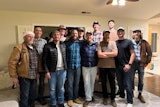For the retail portion of our State of the Industry issue, we spoke we three industry leaders to serve as our "retail voices." In these profiles, they share how their businesses fared last year, their strategies for success and their vision for the future. For 2013, we spoke with Brian Quint, Merry Wise and Steve Ruscigno.

With a history spanning more than 50 years, Aqua Quip is a staple of the Northwest. CEO Brian Quint classifies Aqua Quip as a higher-end fully-integrated retail/service/construction business, which now boasts nine locations and 75 employees. While revenue stalled for the past few years, 2012 marked Aqua Quip’s first year of growth since the recession, success Quint credits to an evolved retail strategy in light of the growth of online retailers.
How was your 2012 overall?
Last year was a good comeback year, particularly on the retail side of the business. We hadn’t seen much in the way of revenue growth in 2009, 2010 and 2011, but we actually saw growth in 2012. It was single-digit growth, but still, it was nice to see some revenue growth come back.
Did you try any new strategies that would account for that?
The area of our business that saw growth — which was really in the retail stores — pretty much came in what we call our “big ticket” category. That includes hot tub sales, barbecue sales and we’re also in the fireplace products, or what we call hearth industry.
The converse to that is chemicals, supplies and accessories for existing pool and hot tub owners. We didn’t really see much growth there at all; in fact, we didn’t really see any revenue growth in after-market products for existing pool and spa owners. And quite frankly, I don’t expect to see a lot of growth in that category of our business because that’s the part that’s the most vulnerable to what I refer to as the “non-traditional channel.” In the old days, it was the segment of the business that was most vulnerable to mail order, and nowadays, it’s the segment of the business that’s most vulnerable to e-commerce, Internet and particularly the likes of Amazon and people like that.
So we’re putting more energy toward the segments of our business that are less vulnerable to the Internet and we’re trying to align with products and/or manufacturers that have a solid Internet pricing/MAP pricing/LAP pricing strategy. For example, the barbecue business: every barbecue we sell, particularly the Weber line, is available on the Internet. But Weber has very strict MAP pricing policies that they enforce, so there is a way to still make money selling Weber in your stores if you’re competing against someone who is listing Weber on Amazon or elsewhere.
As far as pool and spa manufacturers are concerned, what are your thoughts on MAP pricing?
I think MAP pricing is really good on the assumption of a couple of things. There have to be teeth to the MAP pricing policy. So the manufacturer has to be willing to make difficult decisions with who they’re willing and unwilling to sell to if they’re putting MAP pricing in place. If all they’re doing is offering up MAP pricing but are unwilling to support it and enforce it, then it’s just a bunch of garbage.
Secondly, I think MAP pricing puts a lot of pressure on the manufacturer to be innovative in what they’re selling. And why I think that’s important is that if you’re a manufacturer and you’ve got something special, unique or innovative to sell, guys like me will want to carry it in our stores. And therefore, if there’s MAP pricing associated with that innovative product, if I’m thinking about violating that pricing, I’ve got to feel strongly enough about the product, its uniqueness, its innovation, its whatever, to where I don’t want to lose it.
How effective is MAP pricing in the pool and spa industry?
I think it’s getting better. Three or four years ago, there was very little MAP pricing going on. I think the industry is probably getting better at, for example, the robotic pool cleaner segment. Most of the manufacturers have multiple product lines. They have a product line that’s being sold strictly to the brick-and-mortar retail guy like me, and then they’re letting another brand be sold to anybody and everybody online. That’s fine — make sure you’re giving the brick-and-mortar specialty guy something unique to sell and then stand tall on the pricing enforcement of MAP pricing, otherwise don’t bother.
I think the pool and spa industry is probably quite honestly not doing as well as the barbecue industry. However, every year, we’re seeing manufacturers get better at it. And I had conversations last week at meetings in New York about a major equipment manufacturer that is now willing to literally start cutting off customers if they do not adhere to MAP pricing. Up until recently, I really have not heard of many large manufacturers willing to literally turn business down. And so now I think we’re starting to see that. It’s not universal, but it’s trending in the right direction.
What’s the biggest challenge of the pool/spa industry?
Everybody’s going to say Amazon and the Internet. And I think that’s a throwaway answer. The biggest thing we need to constantly be thinking about is what segments of our business are least vulnerable to things like the Internet, and that’s where we should be putting our energy. Products that are either being sold effectively thanks to MAP pricing on the Internet or the products and/or services that we sell in our business that are not vulnerable and can’t be bought on the Internet.
For example, people really aren’t buying hot tubs on the Internet yet. There are hot tubs on the Internet, no question. But the reality is most hot tubs are being sold through retail stores. Service, route maintenance, reoccurring maintenance, pool cleaning: those products are not being sold on the Internet. So put your energy in growing your route maintenance business or your technical service business because those products are not available on the Internet. So I think the biggest challenge is how do you build a durable business model based upon how the world is changing — there’s a lot of pressure on specialty retail because of where consumer behavior is taking people to shop.
That’s definitely a proactive way of thinking about the Internet’s impact on brick-and-mortar stores.
Complaining about the Internet is like complaining we have to breathe. I could lay awake at night worrying about Amazon, or I could go, “Okay, I’ve got 75 employees. What are the things I can do today, tomorrow, the day after tomorrow that are going to ensure I can meet payroll each and every week? What are the things that are going to be the most durable for our business?” And those are the things we spend all of our time thinking about. If all you do is worry about the Internet, you’re not worrying about the things you can do to survive.
What are your goals for 2013?
For the last few years, 2008, 2009 and 2010 for that matter, since sales weren’t growing, we spent a lot of time focusing on how to cut costs and how to get lean. We’re now leaner, and we’ve gotten to the point where we’ve right-sized the operating structure of our business. So our goals in 2013 are to stay diligent on staying lean, and then bust our chops to try to incrementally, even one percentage point at a time, grow the business back in the areas that are most opportune.
If you stay lean, and even modestly incrementally grow the business, then it will enhance the company’s profitability, and if it enhances the company’s profitability, it’ll enhance the company’s long-term health.
Comments or thoughts on this article? Please e-mail [email protected].
Want more from our Retail State of the Industry results?See Part I and Part II of our survey findings.












































